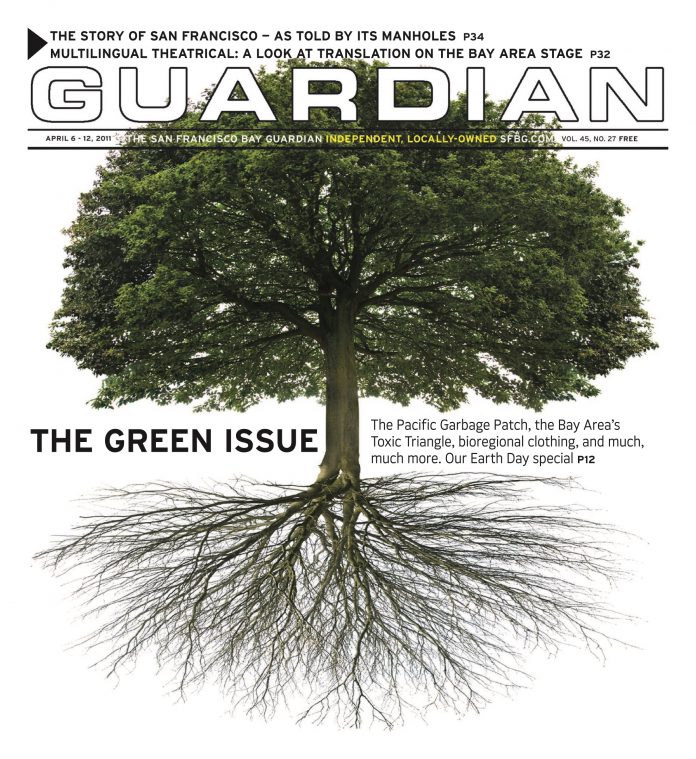rebeccab@sfbg.com ; caitlin@sfbg.com
GREEN ISSUE Planting indigo seedlings in a leaky greenhouse in the mist of a cold Marin County afternoon, Rebecca Burgess thinks about what she’s going to wear. She’s not a fashion model, or a clotheshorse, but she is on a yearlong quest to attire herself only in garments that were sourced and produced bio-regionally — or within a 150-mile radius of home — an area she calls her local fibershed.
Why take on such a challenge? “If we don’t want BP oil spills, it’s about more than just not fueling our cars with it,” Burgess says. While many activists seeking to unplug from oil dependency have worked to encourage bicycles, local agriculture, and reusable shopping bags, her approach takes on the materials we use to clothe our bodies.
Half of all jeans sold annually in the United States — around 200 million pairs — are produced in the Xintang township in China’s Pearl River Delta, where a Greenpeace study found hazardous organic chemicals and acidic runoff in the watershed, both of which may contribute to profound health risks for factory workers and their communities.
Of course, oil is consumed in the transport of factory-made garments halfway across the globe. But as Burgess notes, that’s only part of the reason for her project, which so far has yielded a book on the making of natural dyes and a plan for a community cotton mill in Point Reyes.
She’s also concerned about the synthetic fibers mass-manufactured clothes are made of. “We’re wearing a lot of plastic,” she notes. Not just plastic: petrochemicals, formaldehyde, and carcinogenic polycrylonitriles can all be used to produce your outfit— materials that seep into your pores when you’re active and can hardly be considered ideal to wear against your skin.
To limit support of the oil-reliant garment industry, Burgess envisions a collaboratively created source of clothing made from materials and processes that are — unlike the heavy-metal laden industrial effluent from denim dyes flowing into China’s Pearl River — completely nontoxic. To that end, she’s linking natural fiber artisans and raw material providers throughout the region with the fibershed project, which aims to bolster local clothing production.
Today, she’s the poster child for her effort. Burgess sports striped alpaca kneesocks, an organic cotton skirt sewn by a friend, and a wool sweater her mom knitted with handmade yarn, sourced from a sheep farmer they know. The clothes look well-loved, which makes sense: relying on one’s fibershed for a wardrobe is not easy. When Burgess first embarked on her yearlong bioregional clothing challenge, there wasn’t much in her dresser. “I lived out of three garments for weeks,” she laughs. “People were like, ‘You’re wearing the same thing over and over and over again.'<0x2009>”
But she found that she wasn’t the only one who believed that a change was possible in our closets. Friends, family, and a wider community of shepherds, cotton growers, knitters, seamstresses, and artisans all pitched in to help her along with the project. Burgess says this growing network underlies what it will take for communities to transition to a more sustainable lifestyle. “All this is about encouraging more relationships.”
There’s Sally Fox, whose non-genetically modified colored cotton operation in the Capay Valley is the culmination of years of seed-selecting for natural color tones. There’s the 96-year old sheep farmer in Ukiah. Not to mention the hip fiber artisans based in Oakland and the young fashion students in San Francisco who were inspired by her project.
“It’s not just of value to an old spinster community, it’s of value to a young, hip generation of people who want to live in a carbon-free economy,” Burgess notes. “A bunch of urban young people are really into fibers.” Most, she adds, are women.
Burgess makes her own clothing, too, and to research her book (Harvesting Color, Artisan, 180 p., $22.95) traversed the country learning from female “wisdom-keepers,” women whose craft practices were based on passed-down traditions encouraging the health of their ecosystems.
Today is part of her latest endeavor: growing her own indigo dye so that locally made garments can be dyed blue sustainably. Her day’s work entails planting 400 indigo seeds in flats filled with soil from a ranch down the road. This spring and summer, she plans to raise 1,000 indigo plants in three garden plots just outside the greenhouse. The day the Guardian came to visit, sheep lounged in the pasture beyond her garden plots, as if to illustrate the point that this process won’t require any long-distance transport.
She realizes that few people have a greenhouse to plant indigo in, much less the time necessary to produce their own clothing — or the money needed to dress in handcrafted pieces. But by proving that it’s possible to wear clothes that were created by your own community, she hopes that people will at least “settle for second best, which in this case is wearing organic, American-made materials.”
Even that would be something — right now clothes just aren’t on most of our sustainability compasses. As an example, Burgess recalls a panel discussion she attended at which sustainable food champions Michael Pollan and Joel Salatin were speakers. Someone (“And it wasn’t even me!” she insists) asked them what role garments played in a sustainable lifestyle. “And they were speechless. They didn’t have a thing to say.”
It was a PR challenge Burgess was happy to assume — she has since struck up an e-mail correspondence with Pollan, which she hopes will spread her message further. “Clearly we need some education.”
Join Burgess and other yarn producers for a locally made fashion show and to see plans for their community mill May 1 at Toby’s Feed Barn in Point Reyes. For more information call (415) 259-5849 or visit www.rebeccarburgess.com

